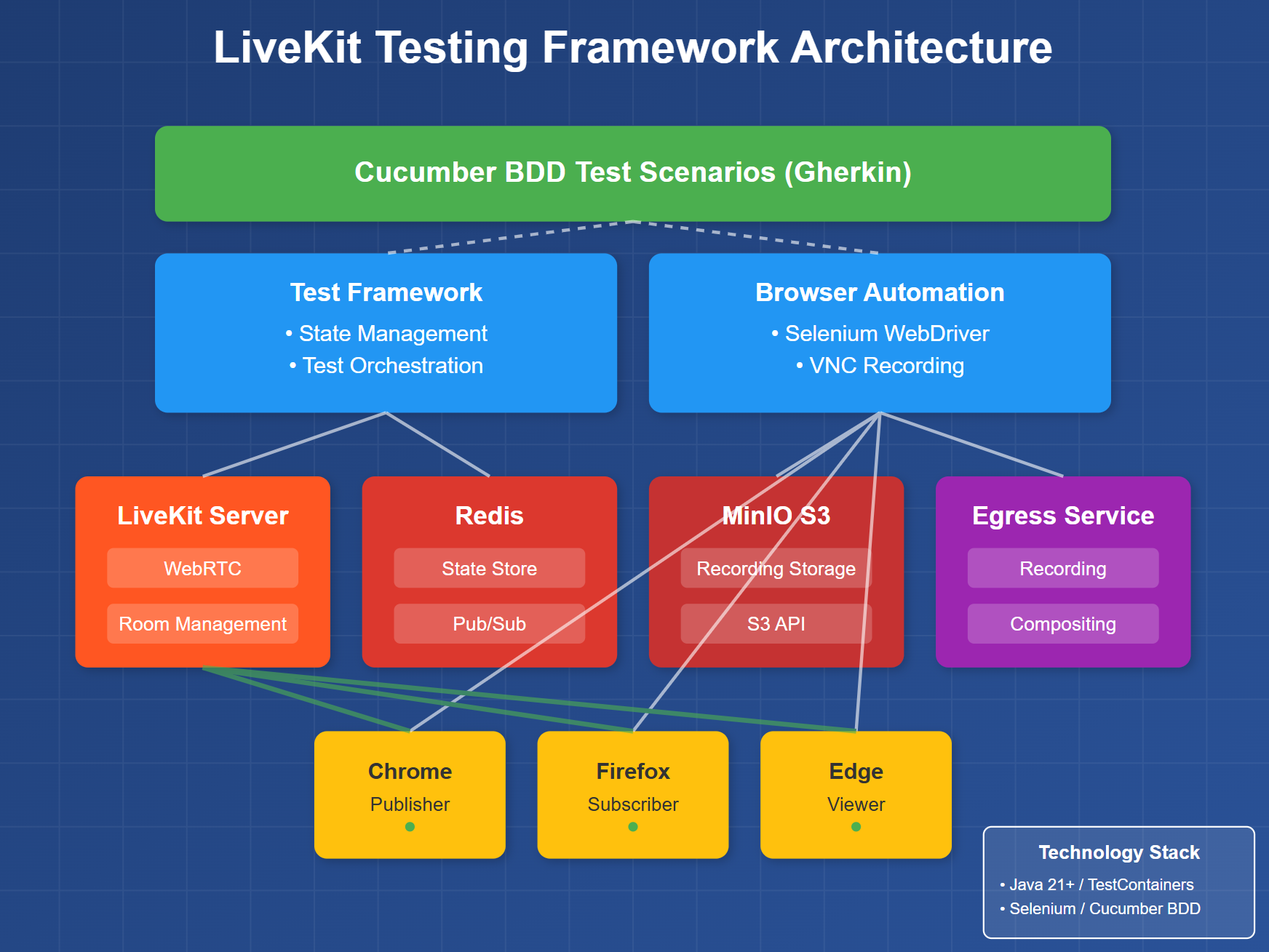Video Streaming Integration Testing: A Practical Framework for LiveKit
Posted on August 7, 2025
Solving the testing challenges for real-time video platforms with comprehensive BDD automation for LiveKit integration
Why WebRTC Testing Remains Difficult
Testing real-time video applications presents unique engineering challenges that standard testing approaches fail to address. The complexity stems from multiple interconnected systems: WebRTC peer connections, media stream handling, Docker containers, browser automation, cloud storage, and event-driven architectures.
For engineering teams using LiveKit, these challenges multiply. You’re not simply validating API responses or UI interactions—you’re ensuring that live video streams flow correctly between participants, recordings capture properly, and system events fire in the correct sequence.
Common testing bottlenecks teams encounter:
- Manual validation requires multiple browsers and a significant time investment<
- Flaky integration tests due to asynchronous operations and timing dependencies
- Inability to reliably test edge cases like participant disconnections
- Manual verification of recording outputs and storage operations
- CI pipelines that can’t handle WebRTC’s complexity
A Comprehensive Testing Solution
The LiveKit Testing Framework tackles these challenges through systematic automation designed for teams building production video applications.
Core Capabilities
Full-Stack WebRTC Automation
- Automated browser sessions with real media streams (not mocked)
- Docker orchestration for LiveKit, Redis, MinIO, and Egress services
- Behavior-driven development using Cucumber for readable test specifications
- Session recording via VNC for debugging test failures
Enterprise Infrastructure Features
- TestContainers integration for reliable Docker management
- MinIO S3 storage validation for recording pipelines
- Complete webhook event verification
- Support for all 17 LiveKit permission configurations
Modern Development Workflow
- Java 21+ leveraging latest language features
- Readable test scenarios using Gherkin syntax
- Centralized state management for multi-participant testing
- Comprehensive logging with automatic failure capture
Practic Applications
Engineering Teams
Challenge: Validating multi-participant room behavior with dynamic participant management.
Traditional method: Manual testing across multiple browsers, hoping edge cases don’t surface in production.
Framework approach:
Given a LiveKit server is running in a container with service name "livekit1"
And an access token is created with identity "Alice" and room "MultiParticipantRoom" with grants "canPublish:true"
And an access token is created with identity "Bob" and room "MultiParticipantRoom" with grants "canPublish:true"
When "Alice" connects to room "MultiParticipantRoom" using the access token
And "Bob" connects to room "MultiParticipantRoom" using the access token
And participant "Bob" is removed from room "MultiParticipantRoom" using service "livekit1"
Then "Bob" should see disconnection in the browser
And participant "Alice" should be publishing video in room "MultiParticipantRoom"
And "mockserver1" should have received a "participant_left" event for participant "Bob"The framework automates browser management, container setup, and validation—providing consistent, repeatable test execution.
Technical Leaders
Measurable Benefits
- Efficiency Gains: Reduce manual testing from hours to minutes per release cycle
- Quality Improvements: Identify integration issues before customer impact
- Development Speed: Enable rapid iteration on video features with a safety net
- Communication Clarity: BDD scenarios document expected system behavior
Operational Advantages
- Eliminate manual QA bottlenecks for video features
- Enable true continuous integration for WebRTC functionality
- Decrease production incidents related to video connectivity
- Scale test coverage without proportional resource increase<
Platform and DevOps Teams
Testing Infrastructure as Code
- Container environments matching production architecture
- Automated lifecycle management with proper resource cleanup
- Version-controlled test specifications evolving with features
- CI/CD compatible without leaving orphaned resources
Debugging and Monitoring
- VNC recordings for visual debugging of test failures
- Container logs aggregated for troubleshooting\
- S3 recording validation for storage pipelines
- Event sequence verification for distributed systems
Technical Implementation
The framework employs enterprise architectural patterns:
Modular Design
- Infrastructure layer managing Docker and browser automation
- State management layer ensuring test isolation and data consistency
- Testing layer combining unit and integration test capabilities
Techn Stack
- Java 21+ provides modern language capabilities and performance
- TestContainers ensuring reliable Docker-based testing
- Selenium WebDriver enables real browser automation
- Cucumber supporting business-readable test specifications
Engineering Patterns
- Dependency injection for proper test isolation
- Automatic resource cleanup prevents memory leaks
- Generic type safety for container and state access
- Configuration management supporting version testing
Quick Setup
The framework delivers value immediately:
# Execute full test suite
./gradlew test
# Run specific test scenarios
./gradlew test --tests "ro.stancalau.test.bdd.RunCucumberTests" \
-Dcucumber.filter.name="Multi-participant recording with egress"
# Test against different LiveKit versions
./gradlew test -Plivekit_docker_version=v1.8.4All features work out of the box—WebRTC testing, multi-participant scenarios, recording validation, and CI/CD integration.
Rapid adoption path
- Hour 1: Clone, run
./gradlew test, see comprehensive test coverage in action - Day 1: Write your first custom test scenario using existing step definitions
- Week 1: Full integration into your CI/CD pipeline with custom business logic
Competitive Differentiation
For organizations building video platforms, this framework represents a fundamental capability gap closure. It transforms WebRTC testing from a manual bottleneck into an automated strength.
Key outcomes: Engineering teams focus on feature development rather than manual validation. Releases deploy with confidence. Customer-reported video issues decrease significantly.
The LiveKit Testing Framework is open source and ready for immediate use. Built to address the real challenges of testing WebRTC applications, it provides a practical foundation for teams working with LiveKit.
- S Prev
- s

What do you think? Share your thoughts!